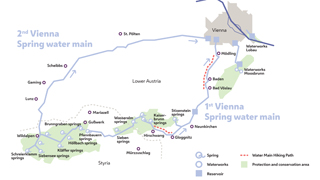The Second Vienna Spring Water Main - A History of Vienna's Water Supply

Download map (73 KB PDF)
Despite the upgrading of the First Vienna Spring Water Main, the incorporation of the suburbs (1890/92) entailed renewed drinking water supply bottlenecks. After extensive preliminary efforts, works for the Second Vienna Spring Water Main began in 1900. The main was built under Mayor Karl Lueger for the amount of 100 million Crowns and financed through public loans.
From Hochschwab to Vienna in 36 hours
10,000 workmen were employed to build the pipeline from the springs in the Styrian Salza Valley in the Hochschwab Massif to the City of Vienna, covering a distance of over 180 kilometres. More than 100 aqueducts and 19 inverted siphons (based on the law of communicating vessels) with a length of up to 2.5 kilometres had to be constructed to cross rivers and valleys aboveground or belowground. The flow-time of the water from spring to city is roughly 36 hours.
Inauguration in 1910
The Second Vienna Spring Water Main was inaugurated on 2 December 1910 by Emperor Francis Joseph I at the Ceremonial Hall of Vienna City Hall. For this occasion, the two fountains in City Hall Park were for the first time operated with mountain spring water. Last but not least, the construction of this pipeline had a very beneficial effect on public health. As a result of the now reliable supply with fresh mountain water, it was possible to build public baths and open-air swimming-pools in all municipal districts of Vienna. In 1973, a protection and conservation zone was defined under water law to safeguard the springs in that area.
The First Main
City of Vienna | Vienna Water
Contact form
